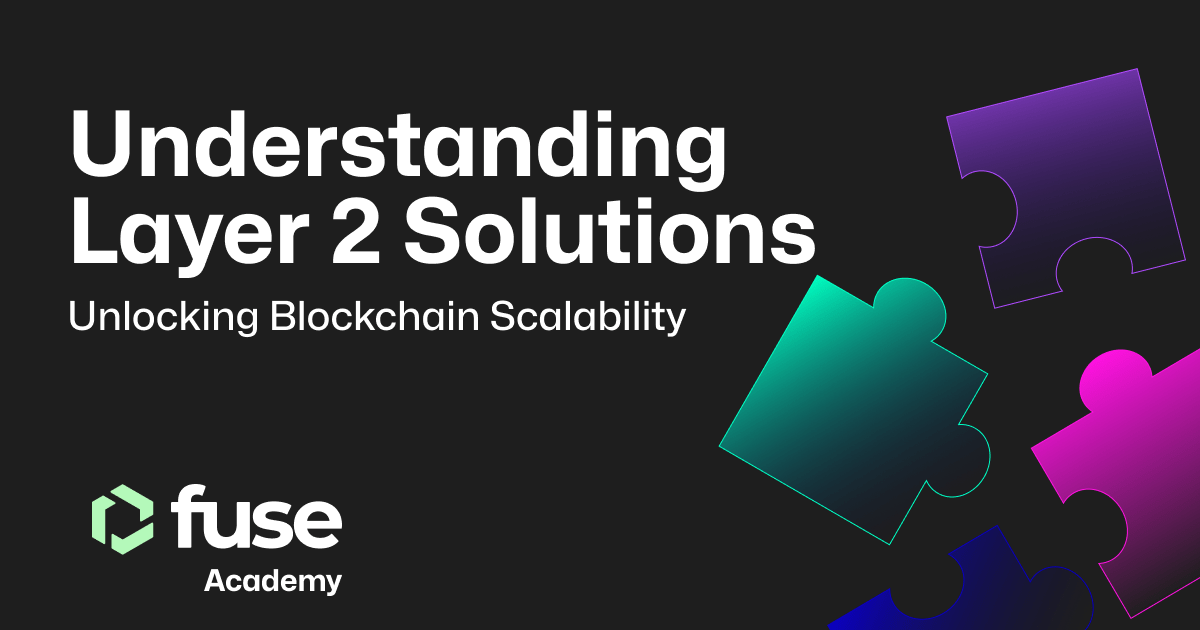Layer 2 refers to any off-chain network, system, or technology built on a blockchain.
As you traverse the Web3 landscape seeking information and knowledge, one term you may have encountered is “Layer 2.” But what exactly does it mean, and how does it contribute to the growth and scalability of blockchain networks?
Currently, the Fuse blockchain is a Layer-1 network, meaning it’s a base blockchain on which secondary blockchain networks and applications are sometimes built. Bitcoin and Ethereum are the two biggest Layer 1 (L1) blockchain networks worldwide. L1 blockchains provide the basic infrastructure and security that Layer 2 (L2) blockchains need to function.
At the end of 2023, Fuse Network embarked on an ambitious journey to create an innovative Ethereum-based Zero Knowledge (ZK) Layer-2 (L2) network, utilizing the formidable capabilities of the Polygon Chain Development Kit (CDK). This comprehensive guide delves deep into Layer 2 solutions, exploring their core principles, benefits, and real-world applications.
What is Layer 2?
Layer 2 refers to any off-chain network, system, or technology built on a blockchain, commonly known as a Layer 1 network. The primary purpose of Layer 2 networks is to extend and enhance the capabilities of the underlying blockchain, offering solutions to some of the critical challenges faced by blockchain ecosystems.
One fundamental requirement for a network, system, or technology to be considered a Layer 2 is that it inherits the security of the base-layer blockchain. This means the underlying blockchain network must verify and confirm transaction data rather than rely on a separate set of nodes or consensus mechanisms.
For instance, despite their utility, sidechains are often not considered true Layer 2 solutions because they often deploy their consensus mechanisms and validators, resulting in a different set of security guarantees than the base layer chain.
The essential role of Layer 2 solutions is to address the issue of scalability while maintaining decentralization and security—a problem often referred to as the blockchain scalability trilemma.
According to this trilemma, blockchains cannot simultaneously achieve scalability, security, and decentralization; these three fundamental aspects must be trade-offs. Layer 2 solutions emerge as a critical component in balancing these trade-offs.
The Need for Layer 2 Solutions
Since its inception in 2008, blockchain technology has garnered immense attention and adoption. However, it has also faced substantial limitations, leading to high fees and slow transaction execution times. The blockchain scalability trilemma, as coined by Ethereum co-founder Vitalik Buterin, highlights the inherent challenge of achieving scalability while maintaining security and decentralization.
Layer 2 solutions have emerged as a response to this challenge. They are built on the premise that blockchains often take on too many roles, including execution, data availability, and consensus. This article focuses solely on the execution layer, which encompasses transaction processing and throughput.
How Layer-2 Solutions Work
Layer 2 solutions typically consist of two primary components:
A network that processes transactions: This is where fast execution of transactions and computations occurs off-chain. Layer 2 networks can vary in how they achieve high throughput.
A smart contract on the underlying blockchain: This contract resolves disputes and achieves consensus on the state of the Layer 2 network by anchoring it to the base blockchain. This ensures the security and integrity of Layer 2 operations.
Payment Channels
One example of a Layer 2 solution is payment channels. These enable the off-chain transfer of on-chain tokens between users by pre-funding liquidity into a channel. Users agree on allocating funds within the channel through cryptographic signatures, enabling fast and cost-effective peer-to-peer transactions. When closing the channel, payment channels drastically reduce on-chain transaction fees by bundling multiple transfers into a single on-chain transaction.
Rollups
Another approach to Layer 2 scalability is through rollups. Rollups execute smart contract state changes off-chain and then provide proofs of these changes on-chain. They achieve scalability through several methods:
- Off-Chain Execution: Rollups perform transaction processing off-chain, reducing the computational load on the base blockchain.
- Batch Transactions: Transactions are batched together, reducing on-chain gas costs and offering a more cost-effective solution.
- Fewer Validators: Layer 2 solutions inherit the security guarantees of the underlying blockchain, allowing them to operate with fewer validators. Validators often have more advanced hardware for faster transaction processing.
Layer 2 Security: The Importance of Proof
For Layer 2 solutions to maintain the security guarantees of the base chain, they rely on cryptographic proof. These proofs ensure that transactions and state changes are valid. Two primary forms of proofs are essential in Layer 2 solutions:
- Fault Proofs assume all transactions are valid by default but allow for disputes. Participants can provide proof that a transaction is incorrect during a dispute period, leading to on-chain validation.
- Validity Proofs proactively prove the correctness of transactions and computations on the Layer 2 network, preventing faulty or malicious transactions from settling on the base chain.
Scaling Blockchains
Payment channels, rollups, and Layer 2 solutions represent sustainable and long-term approaches to the blockchain scalability problem. They support the growing adoption of Web3 applications while enhancing the overall user experience. While the blockchain landscape continues to evolve, developers and researchers are tirelessly working to find viable solutions that bring the promises of Web3 to the forefront of society.
Incorporating Layer 2 solutions into blockchain ecosystems represents a significant step towards realizing the full potential of this groundbreaking technology. As the blockchain industry continues to evolve, the scalability and efficiency offered by Layer 2 solutions will become increasingly vital.
In conclusion, Layer 2 solutions are pivotal in addressing the scalability challenges of blockchain networks. They offer faster transaction processing, reduced costs, and enhanced scalability, all while preserving the security and decentralization of blockchain technology’s core principles. As blockchain technology matures, Layer 2 solutions will undoubtedly play a crucial role in its growth and adoption.
.svg)
.svg)











